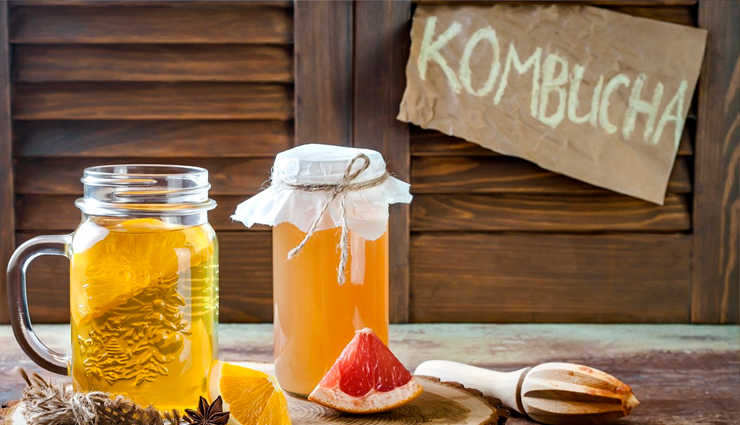- Home›
- Healthy Living›
- This Homemade Tea Is Very Effective In Treating Peptic Ulcers
This Homemade Tea Is Very Effective In Treating Peptic Ulcers
By: Pinki Thu, 09 July 2020 5:15:11

Kombucha is a fermented drink (a type of vinegar) prepared using black tea or green tea as a base, cane sugar or honey as a sweetener and fermented by SCOBY (Symbiotic Colony of Bacteria and Yeast). It is known for its health benefits as probiotic. It contains B vitamins, enzymes, acetic acid, gluconic acid and lactic acid. Overall, it is a good supplement for stomach, liver, intestines, joints and immune system.
The antioxidant property of Kombucha tea helps in ulcer healing. A study suggests it reduces gastric acid secretion and protects mucin content of the gastric membranes. The ulcer healing effect of Kombucha tea is promising and as effective as omeprazole.
Ingredients
3 1/2 quarts water
1 cup sugar (regular granulated sugar works best)
8 bags black tea, green tea, or a mix (or 2 tablespoons loose tea)
2 cups starter tea from last batch of kombucha or store-bought kombucha (unpasteurized, neutral-flavored)
1 scoby per fermentation jar, homemade or purchased online
Optional flavoring extras for bottling: 1 to 2 cups chopped fruit, 2 to 3 cups fruit juice, 1 to 2 tablespoons flavored tea (like hibiscus or Earl Grey), 1/4 cup honey, 2 to 4 tablespoons fresh herbs or spices

Method
# Bring the water to a boil. Remove from heat and stir in the sugar to dissolve. Drop in the tea and allow it to steep until the water has cooled. Depending on the size of your pot, this will take a few hours. You can speed up the cooling process by placing the pot in an ice bath.
# Once the tea is cool, remove the tea bags or strain out the loose tea. Stir in the starter tea. (The starter tea makes the liquid acidic, which prevents unfriendly bacteria from taking up residence in the first few days of fermentation.)
# Pour the mixture into a 1-gallon glass jar (or divide between two 2-quart jars, in which case you'll need 2 scobys) and gently slide the scoby into the jar with clean hands. Cover the mouth of the jar with a few layers tightly-woven cloth, coffee filters, or paper towels secured with a rubber band. (If you develop problems with gnats or fruit flies, use a tightly woven cloth or paper towels, which will do a better job keeping the insects out of your brew.)
# Keep the jar at room temperature, out of direct sunlight, and where it won't get jostled. Ferment for 7 to 10 days, checking the kombucha and the scoby periodically.
# After 7 days, begin tasting the kombucha daily by pouring a little out of the jar and into a cup. When it reaches a balance of sweetness and tartness that is pleasant to you, the kombucha is ready to bottle.
# Before proceeding, prepare and cool another pot of strong tea for your next batch of kombucha, as outlined above. With clean hands, gently lift the scoby out of the kombucha and set it on a clean plate. As you do, check it over and remove the bottom layer if the scoby is getting very thick.
# Measure out your starter tea from this batch of kombucha and set it aside for the next batch. Pour the fermented kombucha (straining, if desired) into bottles using the small funnel, along with any juice, herbs, or fruit you may want to use as flavoring. Leave about a half inch of head room in each bottle. (Alternatively, infuse the kombucha with flavorings for a day or two in another covered jar, strain, and then bottle. This makes a cleaner kombucha without "stuff" in it.)
# Store the bottled kombucha at room temperature out of direct sunlight and allow 1 to 3 days for the kombucha to carbonate. Until you get a feel for how quickly your kombucha carbonates, it's helpful to keep it in plastic bottles; the kombucha is carbonated when the bottles feel rock solid. Refrigerate to stop fermentation and carbonation, and then consume your kombucha within a month.




-1713439689-lb.jpg)
